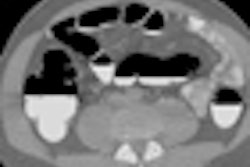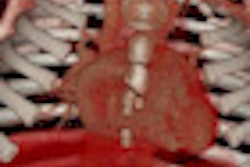VIENNA - A French study presented Sunday at the European Congress of Radiology (ECR) found that nearly a third of mild contrast reactions actually are allergic in nature and might require referral to an allergist as soon as they become apparent.
Contrast reactions have become a major issue in radiology, from nephrogenic systemic fibrosis (NSF) with gadolinium-based contrast agents to kidney problems with iodinated contrast media. Managing these reactions quickly and effectively can have a positive impact on patient care.
With that in mind, Dr. Olivier Clément, Ph.D., from European Hospital Georges Pompidou in Paris presented results from the CIRTACI study, a multicenter, prospective investigation in France examining contrast agent reactions over four and half years, concluding in March 2009. The study involved 31 centers at university hospitals in France, Clément said.
For the data presented at ECR, Clément and colleagues wanted to test the hypothesis that true allergic contrast reactions would be evident by severe clinical symptoms, with patients exhibiting elevated tryptase levels and positive skin tests. Nonallergic reactions would be evident by less severe clinical reactions, normal tryptase levels, and negative skin tests.
The study included reactions to both gadolinium-based MRI contrast agents and iodinated contrast media. Five gadolinium agents were included in the trial, and 10 iodinated products were involved.
The clinical symptoms were classified according to criteria developed by Ring and Messmer, which segment the severity of reactions into four grades ranging from erythema and facial edema at grade 1 to respiratory and cardiac arrest at grade 4. Clément noted the challenges in performing the study under clinical conditions, as it required the placement of blood drawing equipment on emergency trolleys that could be used immediately as contrast reactions occurred.
The study noted a total of 330 reactions, and in his ECR presentation Clément offered data on the first 97 patients, consisting of 50 men and 47 women with a mean age of 48 years. Each reaction was reviewed by a consensus panel consisting of three clinicians, who reviewed the clinical history and made a final diagnosis as to the nature of the reaction.
Of the total, 20% of the reactions were to gadolinium, while 80% were to iodinated contrast material, primarily after CT injection. Almost all reactions occurred within five minutes of contrast injection, which Clément said was the case because most injections were intravascular. Intra-articular injections typically see more delayed reactions.
|
With both gadolinium and iodine, the more severe the reaction, the less often it happened, Clément said. Also, the more severe reactions tended to be truly allergic.
However, a large number of mild reactions were also allergic, Clément said, with some 30% of grade 1 reactions classified in this way -- a finding that contradicted the researchers' expectations going into the study.
"We would have liked to have 0% [of allergic reactions] in grade 1 and 100% of the reactions in grades 4 and 5," Clément said. "This should change how we consider allergic reactions."
In a side finding, the group found that 65% of patients who exhibited skin reactions to one gadolinium chelate also showed reactions to another gadolinium formulation. But with iodinated contrast media, only 25% of patients with a reaction to one contrast agent also showed a reaction to another medium.
The study's finding that nearly a third of mild contrast reactions were allergic indicates that patients showing signs of even mild reactions should be sent to an allergist, Clément concluded.
"This means we need to rethink how we handle contrast reactions," he said.
By Brian Casey
AuntMinnie.com staff writer
March 7, 2010
Related Reading
MGH study: Adverse reactions to gadolinium contrast are rare, January 22, 2010
Italian researchers cut gadolinium dose -- as well as NSF risk, January 21, 2010
FDA panel: NSF incidence falls with gadolinium restrictions, December 9, 2009
MRI contrast media switch eliminates NSF cases, October 15, 2009
Mayo study finds few serious reactions to CT and MRI contrast, September 21, 2009
Copyright © 2010 AuntMinnie.com




















